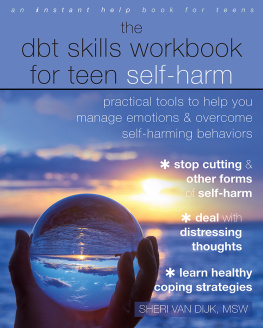Published in 2014 by The Rosen Publishing Group, Inc.
29 East 21st Street, New York, NY 10010
Copyright 2014 by The Rosen Publishing Group, Inc.
First Edition
All rights reserved. No part of this book may be reproduced in any form without permission in writing from the publisher, except by a reviewer.
Library of Congress Cataloging-in-Publication Data
Shea, John M.
Self-injury and cutting : stopping the pain/John M. Shea, M.D.First edition.
pages cm.(Helpline : teen issues and answers)
Includes bibliographical references and index.
ISBN 978-1-4488-9448-2 (library binding)
1. Self-mutilationJuvenile literature. 2. Self-injurious behaviorJuvenile literature. 3.TeenagersMental healthJuvenile literature. 4. College students Mental health. I. Title.
RJ506.S44S54 2014 616.8582dc23
2012047198
Manufactured in the United States of America
CPSIA Compliance Information: Batch #S13YA: For further information, contact Rosen Publishing, New York, New York, at 1-800-237-9932.
CONTENTS
Introduction
Every day, millions of teenagers and young adults suffer from powerful emotions such as sadness, guilt, and anger. These emotions can become overwhelming and make it next to impossible for them to deal with the pressures of everyday life. Some may feel that the only way they can deal with these feelings is to replace the emotional pain with physical pain: they deliberately hurt themselves. They understand that purposefully injuring their bodies is not a healthy behavior. Yet for many, the physical pain from self-injury is the only way they know to get relief from tormenting emotions.
Many of those that self-injure suffer silently. Although they are in emotional turmoil, they often succeed in hiding their feelings from the outside world. Because of fear or shame, they may also hide their self-harming behavior. As a result, there is not a lot of reliable information available about who self-injures and why they do so. This has led to some misconceptions about cutting and self-injury. Some people believe that self-injury is merely a cry for attention. Others think that people who deliberately hurt themselves must be suicidal. Both of these statements could not be further from the truth.
Self-injury may be a hidden problem, but it is also a common one. The Cornell Research Program on Self-Injurious Behavior (CRPSIB), a leader in selfinjury research, estimates that up to 17 percent of young adults have deliberately injured themselves at least once by the time they reach college. Self-injury is not only a problem for teenagers. Children as young as age seven or eight and older adults also deliberately hurt themselves.
Self-injury has many serious consequences. People that self-harm are at serious risk of permanently damaging their bodies. Their self-esteem, often already poor, worsens as self-injury feeds into a cycle of shame, guilt, and social isolation. Relying on self-injury to deal with stress and emotional problems does not work in the long term. Using it as a coping strategy can make dealing with other problems later in life more difficult. Adults who continue to self-harm are at a higher risk of committing suicide.
With the high prevalence of self-injury among teenagers and young adults, there is a good chance that you know someone who is deliberately hurting himself or herself. Perhaps you have a friend that you suspect may be self-injuring. Or perhaps you injure yourself deliberately but do not completely understand why. Here, we will explore the hidden world of self-injury, including what may drive some people to harm themselves and how to seek help for yourself or for a friend. It is hoped that with greater understanding and awareness those that selfharm can get the strength and the support they need to stop the cycle of self-injury.
CHAPTER 1
What Is Self-Injury?
T here are many different terms that are used to describe the action of deliberately hurting oneself: self-injury, self-harm, and self-inflicted violence. These terms largely refer to the same behaviordeliberately hurting ones body in a way that is serious enough to do damage (such as leaving a scar). This deliberate harm is usually done alone, although some people may harm themselves in a group setting. Some doctors use the term self-mutilation because it suggests harming the body without trying to commit suicide, while selfharm, self-injury, or self-inflicted violence could be used to describe suicide attempts as well as nonsuicidal behaviors. In the following sections, all of these terms refer to nonsuicidal self-injury.
An important part of the definition of self-injury is that there is no intention to commit suicide. In fact, many of those who self-injure say that hurting themselves often relieves the tensions and pressures they feel to kill themselves. That is to say, they self-injure in order to escape suicidal thoughts. Sadly, self-injury is a short-term fix for long-term problems, and many young people who have harmed themselves eventually attempt suicide. According to an article in the American Journal of Psychiatry, those that self-injure are up to thirty-four times more likely to kill themselves than those in the general population.
Are tattoos and body piercings a form of self-injury? After all, both do damage to the body. Tattooing uses tiny needles to deposit ink into the skin and is often quite painful. Piercings can be very painful as well: holes are created in the body, and objects are placed in those holes to prevent them from healing as they normally would.
Despite this, tattooing and piercing are not considered self-injury because of the reasons why people engage in these behaviors. Those who receive tattoos or piercings do it for aesthetic reasons. They believe the procedures will make their bodies more distinctive and attractive. The pain is usually an undesired consequence. In contrast, for those that self-injure, the pain is the main reason for the behavior. The physical pain helps them feel better emotionally.
With this difference in mind, it is important to note that there may be overlaps between the groups. Tattoos and piercings are considered allowable and even desirable in most cultures, while self-injury is frowned upon and shameful. Therefore, some people may use tattooing and piercings as a substitute for cutting or other forms of self-harm.
METHODS OF SELF-INJURY
The most common method of self-injury is cutting. Cutting is using a sharp object, such as a knife, razor blade, or a piece of glass, to deliberately scratch or cut skin. Cutting is sometimes referred to as slicing or slashing. Since it is the most common method, the term cutting is sometimes used synonymously with self-injury.
Banging or punching is the second most common self-harming behavior. This involves hitting oneself with fists or a hard object, such as a hammer. Sometimes, bangers throw their bodies against a floor or a wall. One extreme form of banging includes bone breaking, in which a person uses a hard object to break one of his or her bones. Cutting tends to be more common in young women, while males are more likely to hit themselves.


















